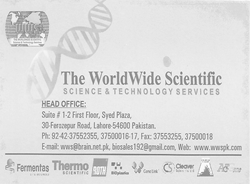Full Length Research Article
Retraction in process: Systems genomics of nucleoporins provides prognostic insights into breast cancer
Rashid Mehmood1*, Kazuya Jibiki2, Zakeya J. Alsafwani1, Muhammad Naseem3, Noriko Yasuhara2*
Adv. life sci., vol. 9, no. 1, pp. 98-110, May 2022
*- Corresponding Author: Rashid Mehmood (Email: rmehmood@alfaisal.edu)
Noriko Yasuhara (Email: yasuhara@chs.nihon-u.ac.jp)
Authors' Affiliations
2. Graduate School of Integrated Basic Sciences, Nihon University, Setagaya-ku, Tokyo, Japan
3. Department of Life and environmental Sciences, College of Health and Natural Sciences, Zayed University, Abu Dhabi, UAE; Department of Bioinformatics, Biocenter, University of Würzburg, Am Hubland, Wuerzburg, Germany
Correction Notice 14/07/2021: This article contains non-technical corrections in the previous version published on 25/05/2022.
Editorial Expression of Concern
20 June 2025: Following publication of this paper, the internal audit (consequent to concerns on quality raised by Web of Science) notified Advancements in Life Sciences about suspected plagiarism. By this Editorial Expression of Concern, we alert the scientific community of the errors as we reconcile the records.
Editorial Note:
25 June 2025: While rerunning the Turnitin originality analysis, similarity index of 8% from a single source was found for this article (out of a total of 17%). Editorial board of Advancements in Life Sciences has started the process of retracting this article due to the above post-publication findings. The process shall be concluded after registering responses from the authors. Meanwhile, full text of the article shall remain unavailable for citations (this notice has been updated following insights derived from relevant COPE cases and the industry standards). Show of cause notice has also been issued to the concerned editorial team member.
Abstract![]()
Introduction
Methods
Results
Discussion
References
Abstract
Background: Nucleoporins (Nups) constitute a large group of proteins that are structurally arranged at the nuclear envelope and facilitate the bidirectional movement of molecules across the nuclear membrane. In addition to regulating the shuttling of ribonucleoprotein complexes, RNAs and proteins, various Nups interact with chromatin either directly or indirectly, thus regulating gene expression. Any mutations or expression anomalies of Nups may lead to abnormal localization of critical molecules, or dysregulated expression of genes that they interact with. A comprehensive genomic study encompassing all Nup genes in relation to breast cancer is lacking.
Methods: We used genomic and transcriptomic datasets from Pan-Cancer TCGA (The Cancer Genome Atlas), Genotype-Tissue Expression (GTEx) and microarray platforms and conducted in silico analysis of all the genes encoding nucleoporins that are associated with the Nuclear Pore Complexes (NPCs). For mutation detection, we used cBioportal; for expression analysis, we used Xena and for patient survival plots, KMPlot was utilized.
Results: The genetic and molecular profile of nucleoporin genes identified multiple mutations and detected aberrant expression in breast cancer. Interestingly, NUP133, AHCTF1, TPR, Nup121L showed simultaneous gene amplification in nearly 10% of breast cancer patients. In addition, deregulated expression of some of the nucleoporins, namely, NUP62, NUP 93, NUP98, NUP155, POM121L12, RAE1, SEC13, TPR were correlated with patient prognosis.
Conclusion: The current study is the first one that unravels a comprehensive molecular and genetic profile of nucleoporins genes in breast cancer and underscores the critical roles of various nucleoporins in cancer progression. The identified molecules may advance our understanding of the etiology of the disease and serve as possible targets for novel therapeutic strategies in cancer.
Keywords: Nuclear Pore Complexes (NPCs); Nucleoporins; Breast cancer; Bioinformatics



